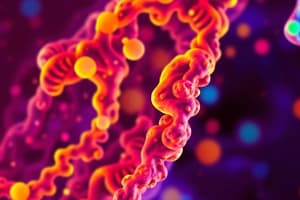Podcast
Questions and Answers
What is the main function of enzymes in food science?
What is the main function of enzymes in food science?
- To consume chemical reactions
- To catalyze chemical reactions in living organisms only
- To decrease reaction rates without being consumed
- To increase reaction rates without being consumed (correct)
Which type of enzyme breaks down starch into sugars?
Which type of enzyme breaks down starch into sugars?
- Lipases
- Cellulases
- Amylases (correct)
- Proteases
What is the role of enzymes in food preservation?
What is the role of enzymes in food preservation?
- To prevent spoilage and extend shelf life (correct)
- To enhance fermentation
- To improve food texture
- To detect and measure food components
In which industry is the application of proteases used to coagulate milk in cheese production?
In which industry is the application of proteases used to coagulate milk in cheese production?
What is the factor that affects enzyme activity and reaction rate?
What is the factor that affects enzyme activity and reaction rate?
What is the purpose of enzyme immobilization?
What is the purpose of enzyme immobilization?
Which of the following is an example of an inhibitor in enzyme activity?
Which of the following is an example of an inhibitor in enzyme activity?
What is the optimal condition for enzyme activity in terms of pH and temperature?
What is the optimal condition for enzyme activity in terms of pH and temperature?
Flashcards are hidden until you start studying
Study Notes
Enzymes in Food Science
Definition and Function
- Biological molecules (proteins) that catalyze chemical reactions
- Increase reaction rates without being consumed by the reaction
- Highly specific to react with specific substrates
Types of Enzymes in Food Science
- Amylases: break down starch into sugars
- Proteases: break down proteins into peptides and amino acids
- Lipases: break down fats into fatty acids and glycerol
- Cellulases: break down cellulose into glucose
Roles of Enzymes in Food Science
- Food Processing: improve texture, flavor, and nutritional value
- Food Preservation: prevent spoilage and extend shelf life
- Food Analysis: detect and measure food components
- Food Production: enhance fermentation, brewing, and baking processes
Applications in Food Industry
- Baking: amylases to break down starch in flour
- Dairy: proteases to coagulate milk in cheese production
- Fruit Juices: pectinases to clarify and improve juice quality
- Meat Tenderization: proteases to break down proteins and improve texture
Factors Affecting Enzyme Activity
- Temperature: optimal temperature ranges for enzyme activity
- pH: optimal pH ranges for enzyme activity
- Substrate Concentration: affects enzyme activity and reaction rate
- Inhibitors: molecules that decrease enzyme activity
Control and Regulation of Enzyme Activity
- Inhibitors: molecules that decrease enzyme activity
- Activators: molecules that increase enzyme activity
- pH and Temperature Control: maintain optimal conditions for enzyme activity
- Enzyme Immobilization: attach enzymes to surfaces to improve stability and reuse
Enzymes in Food Science
Definition and Function
- Enzymes are biological molecules (proteins) that catalyze chemical reactions, increasing reaction rates without being consumed by the reaction.
- They are highly specific, reacting with specific substrates to produce desired products.
Types of Enzymes
Enzyme Classification
- Amylases: break down starch into sugars (e.g., in bread making, beer brewing).
- Proteases: break down proteins into peptides and amino acids (e.g., in cheese production, meat tenderization).
- Lipases: break down fats into fatty acids and glycerol (e.g., in dairy, bakery).
- Cellulases: break down cellulose into glucose (e.g., in fruit juice production).
Enzyme Applications
Food Processing and Production
- Texture Improvement: enzymes enhance food texture (e.g., amylases in baking, proteases in meat tenderization).
- Flavor Enhancement: enzymes improve flavor profiles (e.g., lipases in dairy, amylases in baking).
- Nutritional Value: enzymes increase nutritional value (e.g., proteases in meat tenderization).
- Fermentation and Brewing: enzymes facilitate fermentation and brewing processes (e.g., amylases, proteases).
Food Preservation and Analysis
- Spoilage Prevention: enzymes prevent food spoilage and extend shelf life (e.g., lysozymes in dairy, amylases in baking).
- Component Detection: enzymes detect and measure food components (e.g., glucose, amino acids).
Factors Affecting Enzyme Activity
Optimal Conditions
- Temperature: enzymes have optimal temperature ranges for activity (e.g., 37°C for proteases).
- pH: enzymes have optimal pH ranges for activity (e.g., pH 7 for proteases).
Enzyme regulation
- Inhibitors: molecules that decrease enzyme activity (e.g., competitive, non-competitive, uncompetitive inhibitors).
- Activators: molecules that increase enzyme activity (e.g., metal ions, vitamins).
- pH and Temperature Control: maintaining optimal conditions for enzyme activity.
- Enzyme Immobilization: attaching enzymes to surfaces to improve stability and reuse.
Studying That Suits You
Use AI to generate personalized quizzes and flashcards to suit your learning preferences.




